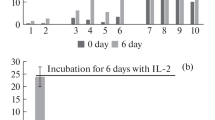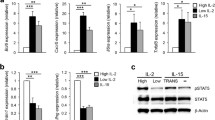Abstract
Interleukin-2 (IL-2)-activated killer cells, also referred to as lymphokine-activated killer (LAK) cells, are stimulated by tumor cells to express cytotoxic activity and to also secrete cytokines such as interferon γ (IFNγ) and tumor necrosis factor α (TNF α). We previously reported that secretion of cytokines by IL-2-activated T cells (LAK-T cells) is dependent on the initial cross-linking of the T cell receptor (TCR)-CD3-molecular complex, but the cross-linking of accessory molecules, such as LFA-1, CD2, CD44 and CD45, on LAK-T cells can enhance this cytokine production. We have developed an approach involving interspecific gene transfer to define further the contributions of LFA-1 and CD2 to the activation of LAK-T cells. The genes for huICAM-1 (a ligand for LFA-1) and huLFA-3 (a ligand for CD2) were transfected singly and in combination into a null mouse melanoma background, and clonal populations of cells that stably express ICAM-1 and/or LFA-3 were derived. Expression of the introduced ICAM-1 and/or LFA-3 by transfected cells enhanced their ability to bind LAK-T cells; the LFA-1/ICAM-1-mediated binding was not further enhanced by activation with phorbol 12-myristate 13-acetate. ICAM-1- and/or LFA-3-transfected cells, in the presence of immobilized anti-CD3, exhibited a greater ability to stimulate IFNγ secretion by LAK-T cells compared to the untransfected parental lines. This experimental system, which allows ICAM-1/LFA-1 and CD2/LFA-3 interactions to occur on the LAK-T cell at a site distal from the anti-CD3 signal, extends our understanding of LAK-T cell activation by establishing that both LFA-1/ICAM-1 and CD2/LFA-3 can mediate co-stimulation via adhesion and signaling events.
Similar content being viewed by others
References
Alcover A, Alberini C, Acuto O, Clayton LK, Transy C, Spagnoli GC, et al (1988) Interdependence of CD3-Ti and CD2 activation pathways in human T lymphocytes. EMBO J 7:1973
Carrera AC, Rincon M, Sanchez-Madrid F, Lopez-Botet M, Landazuri MO de (1988) Triggering of co-mitogenic signals in T cell proliferation by anti-LFA-1 (CD18, CD11a), LFA-3, and CD7 monoclonal antibodies. J Immunol 141:1919
Chong AS-F, Hersh E, Grimes WJ (1988) Blocking of lymphokine activated killer (LAK) cell mediated cytotoxicity by cell-sized beads bearing tumor cell proteins. J Immunol 141:4418
Chong AS-F, Scuderi P, Grimes WJ, Hersh EM (1989) Tumor targets stimulate IL-2 activated killer cells to produce interferon-γ and tumor necrosis factor. J Immunol 142:2133
Chong AS-F, Ybarrondo B, Grimes WJ, Hersh EM, Scuderi P (1990) Phenotypic analyses of lymphokine-activated killer cells that release interferon and tumor necrosis factor. Cancer Immunol Immunother 31:255
Chong AS-F, Boussy IA, Graf LH, Scuderi P (1992) Stimulation of IFN-γ, TNF-α and TNF-β secretion in IL-2-activated T cells: costimulatory roles for LFA-1, LFA-2, CD44 and CD45 molecules. Cell Immunol 144:69
Chong AS-F, Staren ED, Scuderi P (1992) Monoclonal antibodies anti-CD3, anti-TCR-αβ and anti-CD2 act synergistically with tumor cells to stimulate lymphokine-activated killer cells and tumor-infiltrating lymphocytes to secrete interferon γ. Cancer Immunol Immunother 35:335
Damle NK, Doyle LV, Bradley EC (1986) Interleukin 2-activated human killer cells are derived from phenotypically heterogenous precursors. J Immunol 137:2814
Danielian S, Fagard R, Alcover A, Acuto O, Fischer S (1989) The lymphocyte-specific protein tyrosine kinase p56lck is hyperphosphorylated on serine and tyrosine residues within minutes after activation via T cell receptor or CD2. Eur J Immunol: 2183
Denning SM, Dustin ML, Springer TA, Singer KH, Haynes BF (1988) Purified lymphocyte function-associated antigen-3 (LFA-3) activates human thymocytes via the CD2 pathway. J Immunol 141:2980
Dustin ML, Springer TA (1989) T-cell receptor cross-linking transiently stimulates adhesiveness through LFA-1. Nature 341:619
Dustin ML, Selvaraj P, Mattaliano RJ, Springer TA (1987) Anchoring mechanisms for LFA-3 cell adhesion glycoprotein at membrane surface. Nature 329:846
Ferrini S, Miescher S, Zocchi MR, Fliedner V van, Moretta A (1987) Phenotypic and functional characterization of recombinant interleukin 2 (IL-2)-induced activated killer cells: Analysis at the population and clonal levels. J Immunol 138:1297
Graf LH, Kaplann P, Silagi S (1984) Efficient DNA-mediated transfer of selectable genes and unselected sequences into differentiated and undifferentiated mouse melanoma clones. Somatic Cell Mol Genetics 10:139
Graf LH, Rosenberg CD, Mancino V, Ferrone S (1988) Transfer and coamplification of a gene encoding a 96 kDa immune IFN-inducible human melanoma-associated antigen: preferential expression by mouse melanoma host cells. J Immunol 141:1054
Kerensky AM, Robbins E, Springer TA, Burakoff, SJ (1984) LFA-1, LFA-2 and LFA-3 antigens are involved in CTL-target conjugation. J Immunol 132:2180
Kooyk Y van, Weil-van Kemenade P van de, Weder P, Kuijpers TW, Figdor CG (1989) Enhancement of LFA-1-mediated cell adhesion by triggering through CD2 or CD3 on T lymphocytes. Nature 342:811
Kornberg LJ, Earp HS, Turner CE, Prockop C, Juliano RL (1991) Signal transduction by integrins: increased protein tyrosine phosphorylation caused by clustering of β1 integrins. Proc Natl Acad Sci USA 88:8392
Kuhlman P, Moy VT, Lollo BA, Brian AA (1991) The accessory function of murine intercellular adhesion molecule-1 in T lymphocyte activation. Contributions of adhesion and co-activation. J Immunol 146:1773
Lotze MT, Grimm EA, Mazumdar A, Strausser JL, Rosenberg SA (1981) Lysis of fresh and cultured autologous tumor by human lymphocytes cultured in T-cell growth factor. Cancer Res 41:4420
Makoba MW, Sanders ME, Luce GEG, Dustin ML, Springer TA, Clark EA, et al (1988) ICAM-1 a ligand for LFA-1-dependent adhesion of B, T and myeloid cells. Nature 331:86
Marlin SD, Springer TA (1987) Purified intercellular adhesion molecule-1 (ICAM-1) is a ligand for lymphocyte function-associated antigen 1 (LFA-1). Cell 51:813
Meuer SC, Hussey RE, Fabbi M, Fox D, Acuto O, Fitzgerald KA, et al (1984) An alternative pathway of T-cell activation: a functional role for the 50 kd T11 sheep erythrocyte receptor protein. Cell 36:897
Moingeon PE, Lucich JL, Stebbins CC, Reeny MA, Koyasu S, Reinherz EL (1991) Complementary roles for CD2 and LFA-1 adhesion pathways during T cell activation. Eur J Immunol 21:605
Pardi R, Bender JR, Dettori C, Giannazza E, Engleman EG (1989) Heterogeneous distribution and transmembrane signalling properties of lymphocyte function-associated antigen (LFA-1) in human lymphocyte subsets. J Immunol 143:3157
Seed B (1987) An LFA-3 cDNA encodes a phospholipid-linked membrane protein homologous to its receptor CD2. Nature 329:840
Seventer GA van, Shimizu Y, Horgan KJ, Shaw S (1990) The LFA-1 ligand ICAM-1 provides an important costimulatory signal for T cell receptor-mediated activation of resting T cells. J Immunol 144:4579
Seventer GA van, Newman W, Shimizu Y, Nutman TB, Tanaka Y, Horgan KJ, et al (1991) Analysis of T cell stimulation by superantigen plus major histocompatibility complex class II molecules or by CD3 monoclonal aantibody: costimulation by purified adhesion ligands VCAM-1, ICAM-1, but not ELAM-1. J Exp Med 174:901
Seventer GA van, Shimizu Y, Horgan KJ, Luce GEG, Webb D, Shaw S (1991) Remote T cell co-stimulation via LFA-1/ICAM-1 and CD-2/LFA-3: demonstration with immobilized ligand/mAb and implication in monocyte-mediated co-stimulation. Eur J Immunol 21:1711
Shimizu Y, Seventer G van, Horgan KJ, Shaw S (1990) Regulated expression and binding of three VLA (β1) integrin receptors on T cells. Nature 345:250
Springer TA (1990) Adhesion receptors of the immune system. Nature 346:425
Wacholtz MC, Patel SS, Lipsky PE (1989) Leukocyte function-associated antigen 1 is an activation molecule for human T cells. J Exp Med 170:431
Yamada A, Kaneyuki T, Torimoto Y, Daley JF, Prado CM, Yokoyama MM (1992) Signalling from LFA-1 contributes signal transduction through CD2 alternative pathway in T cell activation. Cell Immunol 142:145
Author information
Authors and Affiliations
Rights and permissions
About this article
Cite this article
Chong, A.S.F., Jiang, X., Scuderi, P. et al. ICAM-1 and LFA-3 enhance the ability of anti-CD3 mAb to stimulate interferon γ production in interleukin-2-activated T cells. Cancer Immunol Immunother 39, 127–134 (1994). https://doi.org/10.1007/BF01525318
Received:
Accepted:
Issue Date:
DOI: https://doi.org/10.1007/BF01525318




